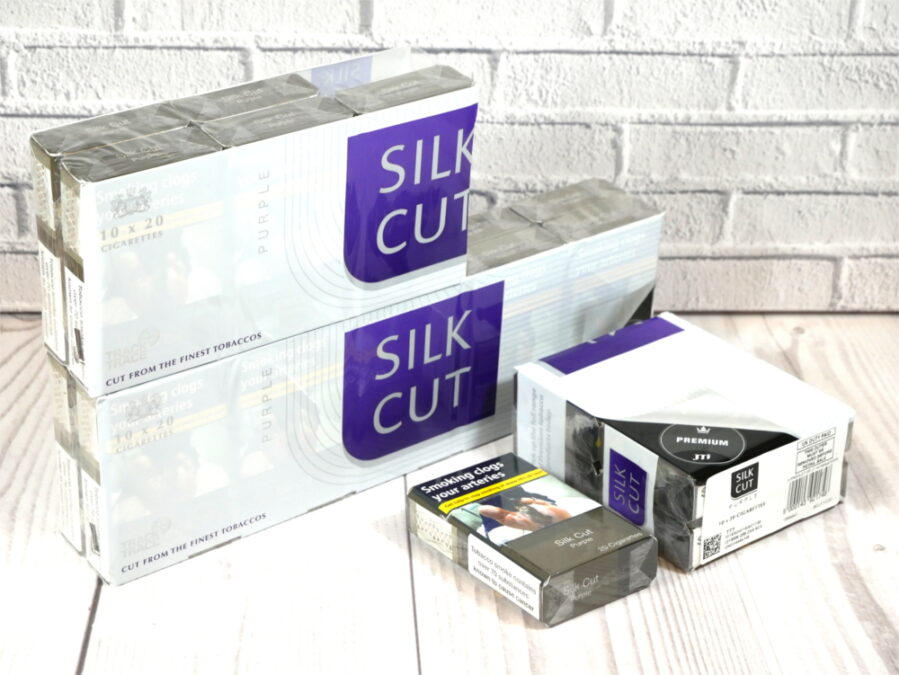What is Silk Cut Purple?
Silk Cut Purple is a prominent product in the Silk Cut cigarette range, a brand long associated with low-tar, lighter smoking alternatives in the UK. Recognisable by its distinctive packaging and smooth flavour, Silk Cut Purple appeals to smokers who want a refined and milder experience without compromising on quality. The cigarette has a loyal following across the country and is widely stocked in high street retailers, supermarkets, and tobacco stores.
Originally introduced during a time when the UK was moving towards healthier tobacco consumption options, Silk Cut aimed to capture a share of the market that was growing increasingly conscious of nicotine intake. Silk Cut Purple built on that brand reputation, offering a cigarette that’s smoother and lower in strength than most traditional products. While its packaging has been affected by government regulation, the product itself remains unchanged in its essence.
Despite common misconceptions, Silk Cut Purple is not a menthol cigarette. The word “purple” in the name is part of the marketing strategy that once distinguished it from other Silk Cut products, though many smokers associate the term with freshness or a slight hint of flavour. However, in the post-menthol ban era in the UK, such associations have largely faded due to restrictions in flavour marketing.
History and Evolution of the Silk Cut Brand
To fully understand Silk Cut Purple, it’s useful to take a look at the history of the Silk Cut brand. Silk Cut was launched in the 1960s and quickly distinguished itself by focusing on low-tar cigarettes. At a time when awareness of the health risks of smoking was increasing, Silk Cut tapped into a market of smokers who weren’t ready to quit but were seeking what they perceived to be a “safer” option.
The brand’s marketing was revolutionary. Rather than show smoking directly, it used surrealist art and minimalistic design to suggest elegance and sophistication. This approach allowed Silk Cut to grow in popularity without appearing aggressive or traditional. Throughout the 70s and 80s, the brand maintained its position as a leader in the light cigarette segment.
Silk Cut Purple was introduced as part of an extended range to offer more tailored smoking experiences. It built upon the reputation of the core brand while standing out due to its distinct identity. Over time, the Silk Cut line came to include variants such as Blue, Silver, and now Purple — each catering to slightly different preferences based on strength, smoothness, and flavour subtleties.
With the UK’s introduction of standardised tobacco packaging in 2016, the visual identity of Silk Cut Purple became less of a selling point. However, the name and reputation continued to attract loyal customers who knew what they were looking for — a balanced, light smoke with consistency in quality.
Flavour Profile and Smoking Experience
Silk Cut Purple delivers a smooth and refined smoking experience. While not flavoured with menthol or additives, the blend is mild and designed for a clean taste. Many smokers describe the experience as light on the throat, with a softer aroma that doesn’t linger heavily. This makes it a preferred choice for those who smoke socially or casually.
Unlike stronger cigarettes that hit the throat with intensity, Silk Cut Purple allows for a more relaxed puffing pattern. It’s well-suited to those who may not smoke daily, or who are looking to reduce their nicotine intake without quitting entirely. The filter is highly effective at reducing harshness, and the cigarette burns at an even pace, creating a steady draw.
When compared to Silk Cut Blue — which is slightly stronger — or Silk Cut Silver, which is the mildest variant, Purple lands comfortably in the middle. It is often the go-to for smokers transitioning from mainstream cigarettes to lighter alternatives. The taste is crisp but not overpowering, making it easy to smoke without the heavy aftertaste associated with more intense brands.
Its popularity among both male and female smokers suggests that Silk Cut Purple hits a sweet spot between sophistication, smoothness, and accessibility. It’s not just about the flavour; it’s about the overall experience — a cigarette that feels light in the hand, burns cleanly, and fits well into a modern lifestyle.
Health Considerations and UK Regulations

As with all tobacco products, Silk Cut Purple is subject to stringent UK health regulations. It is important to stress that no cigarette can be considered safe. While Silk Cut Purple may be lower in tar and nicotine, it still carries the same long-term health risks associated with tobacco use — including cancer, heart disease, and respiratory problems.
However, many smokers see it as a harm-reduction tool. Its lower tar levels are appealing to individuals who are trying to minimise their tobacco exposure without making the leap to quitting. For those in transition, it’s sometimes used as a stepping stone toward less harmful alternatives such as nicotine pouches or vaping.
The UK government has implemented multiple restrictions on cigarette marketing and branding. Since 2016, all cigarette packaging must follow a standardised design: olive green packaging, clear health warnings, and no logos or brand colours. Silk Cut Purple is no exception. It’s sold in these plain packs, making it difficult for consumers to visually distinguish between products at first glance.
Despite this, retailers and loyal users continue to recognise Silk Cut Purple through its name and product code. Furthermore, the law prohibits flavour additives and attractive packaging, which means that Silk Cut Purple has had to rely on its product quality and word-of-mouth to remain relevant.
Consumer Demographics and Popularity
Silk Cut Purple enjoys a strong presence among older adult smokers who value consistency, smoothness, and reduced strength. Many users who previously smoked higher-tar brands have shifted to Silk Cut Purple in a bid to lower their nicotine intake while maintaining a satisfying smoke.
It’s also popular among women and casual smokers. The cigarette’s balanced strength and elegant smoking profile attract individuals who smoke occasionally or socially, rather than those seeking a strong or quick nicotine hit. Over the years, Silk Cut Purple has developed a somewhat niche but loyal base of users who continue to favour it over trendier alternatives.
Availability also plays a role in its continued success. Despite declining cigarette sales in the UK, Silk Cut Purple remains widely stocked in supermarkets, petrol stations, and convenience shops. Retailers understand the brand’s enduring appeal and continue to allocate shelf space for it, even as demand shifts toward vape products and nicotine alternatives.
In terms of pricing, Silk Cut Purple is positioned as a mid-range cigarette. It is neither the cheapest nor the most premium, which aligns with its branding as a sophisticated but accessible option. This pricing strategy has helped it stay competitive without diluting its identity.
Alternatives to Silk Cut Purple
As the tobacco industry continues to evolve, many smokers are seeking alternatives to traditional cigarettes. For those who enjoy Silk Cut Purple, there are several similar options available — both within the Silk Cut family and beyond.
Other light cigarettes like Marlboro Gold, Benson & Hedges Blue, or even brands such as Mayfair Smooth can provide a comparable smoking experience. However, none quite match the particular blend and feel of Silk Cut Purple, which remains unique in its construction.
Roll-your-own (RYO) tobacco is another alternative. Smokers who want more control over the strength and size of their cigarettes often opt for ultra-slim filters and low-tar blends. This approach can reduce costs and allows for more customised consumption.
Outside of tobacco, nicotine pouches and vaping have become popular alternatives. Brands like Nordic Spirit, Zyn, and VELO offer discreet, smokeless nicotine solutions with a wide range of strengths and flavours. Vaping, too, provides a cleaner experience with hundreds of flavour options and varying nicotine levels.
Though these alternatives are marketed as safer, it’s worth noting that they still carry health risks. The key benefit is the reduction of exposure to tar and the hundreds of harmful chemicals found in burning tobacco. For many, this shift represents a conscious decision to move toward harm reduction without giving up nicotine entirely.
Cultural Perception of Silk Cut Purple
Silk Cut, as a brand, once had a cultural cachet that extended beyond just smoking. In the 1980s and 90s, its abstract advertising campaigns became iconic. While those days are gone due to advertising bans, Silk Cut Purple still carries a certain aura among smokers who remember the brand’s heyday.
Among contemporary smokers, Silk Cut Purple is often seen as a “grown-up” cigarette. It’s not associated with rebellious youth culture or flashy gimmicks. Instead, it appeals to those who are informed, selective, and mature in their choices.
Online forums and communities continue to mention Silk Cut Purple favourably, often in discussions about switching from heavier brands or finding a lighter alternative. While the overall market is shrinking, the product’s place within it seems steady, thanks in part to its refined image and consistent quality.
Conclusion
Silk Cut Purple represents a reliable choice for smokers seeking a smoother, lighter experience. Its flavour profile is mild yet satisfying, and its strength level makes it accessible to a wide range of users. While regulations have impacted its packaging and marketing, the quality of the cigarette itself remains a strong selling point.
Despite the changing landscape of tobacco use in the UK, Silk Cut Purple holds its own against both traditional competitors and modern nicotine alternatives. Whether you’re an existing smoker looking for a gentler option or someone considering a step-down from stronger brands, Silk Cut Purple offers a balanced and enjoyable experience.
Its appeal lies not in bold claims or flashy designs, but in consistency, reliability, and a subtle but distinct identity that has earned the loyalty of thousands across the country.
FAQs
What is the nicotine content in Silk Cut Purple?
Silk Cut Purple contains a lower level of nicotine compared to traditional cigarettes. The exact amount can vary slightly but is typically between 0.3 mg and 0.5 mg. It’s designed to offer a smoother hit with reduced harshness.
Is Silk Cut Purple menthol-flavoured?
No. Silk Cut Purple is not a menthol product. It was never explicitly marketed as such, and under UK law, flavoured cigarettes are banned. The name “Purple” refers to its variant type rather than an added flavour.
Can you still buy Silk Cut Purple in the UK?
Yes, Silk Cut Purple is still widely available in the UK. It’s sold in all major retail outlets that stock tobacco products, though in plain packaging with required health warnings.
How does Silk Cut Purple compare to Silk Cut Blue or Silver?
Silk Cut Blue is slightly stronger than Purple, while Silk Cut Silver is milder. Purple strikes a middle ground, offering a smooth yet satisfying smoke without being too light or too heavy.
Are there vape options similar to Silk Cut Purple?
While no vape perfectly mimics Silk Cut Purple, many “classic tobacco” flavoured e-liquids provide a similar mild taste. These include options from brands like Vuse, Elf Bar ELFLIQ, or NicNic’s Smooth Tobacco range.
Why do some smokers choose Silk Cut Purple over other brands?
Silk Cut Purple offers a balance of lightness, flavour, and quality. Many smokers feel it’s less harsh on the throat and appreciate the controlled nicotine delivery, especially when trying to cut down.
Has Silk Cut Purple changed since plain packaging laws?
While the packaging has changed, the cigarette itself remains the same. The blend, quality, and smoking experience of Silk Cut Purple has not been altered despite regulatory changes.
You may also read: $3000 IRS Tax Refund Schedule 2025: Full Payout Timeline, Eligibility & UK Guide


